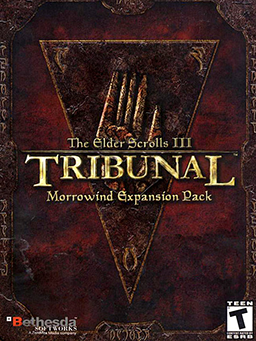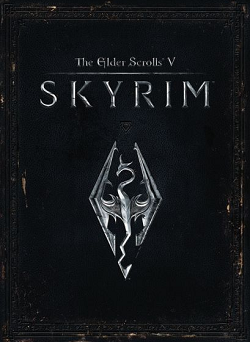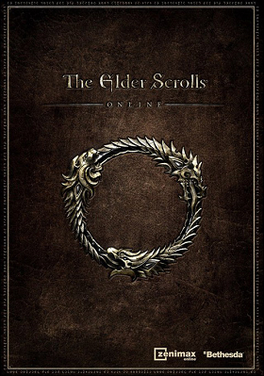Bethesda Softworks LLC is an American video game publisher based in Rockville, Maryland. The company was founded by Christopher Weaver in 1986 as a division of Media Technology Limited. In 1999, it became a subsidiary of ZeniMax Media. In its first 15 years, it was a video game developer and self-published its titles. In 2001, Bethesda spun off its own in-house development team into Bethesda Game Studios, and Bethesda Softworks retained only its publishing function.
The Elder Scrolls is a media franchise of action role-playing video games primarily developed by Bethesda Game Studios and published by Bethesda Softworks. The series focuses on free-form gameplay in an open world. Morrowind, Oblivion and Skyrim all won Game of the Year awards from multiple outlets. The series has sold more than 58 million copies worldwide.

The Elder Scrolls III: Tribunal is an expansion for the role-playing game The Elder Scrolls III: Morrowind by Bethesda Softworks, released on November 6, 2002. The expansion takes place in the city of Mournhold, the capital of Morrowind, and further explores the story of the characters of the "Living Gods", the Tribunal. Developed immediately after the release of Morrowind, the expansion was designed to be a self-contained and complementary experience to gameplay, with the addition of minor gameplay features including alterations to the game's journal and map system. Tribunal was released to positive reviews, with critics praising the game's minor quality of life improvements, greater difficulty, and focused, contained setting, whilst critiquing the linear and short nature of the expansion and technical issues. Bethesda Softworks staff expressed the design of Tribunal was influential to the direction of future expansions in the Elder Scrolls franchise, particularly The Elder Scrolls III: Bloodmoon, released the following year.

The Elder Scrolls III: Bloodmoon is the second and final expansion pack for The Elder Scrolls III: Morrowind, developed by Bethesda Game Studios. It was originally released as an expansion set for Microsoft Windows and is included within the Morrowind: Game of the Year edition for Xbox.

The Elder Scrolls Adventures: Redguard is an action-adventure video game developed and published by Bethesda Softworks. It is unique in The Elder Scrolls series as the only game with a predetermined character and forced third-person point of view.

The Elder Scrolls III: Morrowind is an open-world action role-playing video game developed by Bethesda Game Studios and published by Bethesda Softworks. It is the third installment in The Elder Scrolls series, following 1996's The Elder Scrolls II: Daggerfall, and was released in 2002 for Microsoft Windows and Xbox. The main story takes place on Vvardenfell, an island in the Dunmer province of Morrowind, part of the continent of Tamriel. The central quests concern the demigod Dagoth Ur, housed within the volcanic Red Mountain, who seeks to gain power and break Morrowind free from Imperial reign.

The Elder Scrolls IV: Oblivion is an open-world action role-playing video game developed by Bethesda Game Studios, and published by Bethesda Softworks and 2K. It is the fourth installment in the Elder Scrolls series, following 2002's The Elder Scrolls III: Morrowind, and was released for Microsoft Windows and Xbox 360 in 2006, followed by PlayStation 3 in 2007. Taking place within the fictional province of Cyrodiil, the game's main story focuses on the player character's efforts to thwart a fanatical cult known as the Mythic Dawn that plans to open portal gates to a demonic realm known as Oblivion.

The Elder Scrolls: Arena is an open-world action role-playing video game developed and published by Bethesda Softworks. The first game in the Elder Scrolls series, it was released for MS-DOS on March 25, 1994. The game follows the player trying to uncover a conspiracy against Emperor Uriel Septim VII.

The Elder Scrolls II: Daggerfall is an open-world, action role-playing game published by Bethesda Softworks. The second video game in the Elder Scrolls series, it was released on September 20, 1996, for MS-DOS, following the success of 1994's The Elder Scrolls: Arena. The story follows the player, sent by the Emperor, to free the ghost of King Lysandus from his earthly shackles and discover what happened to a letter sent from the Emperor to the former queen of Daggerfall.

Todd Andrew Howard is an American video game designer, director, and producer. He serves as director and executive producer at Bethesda Game Studios, where he has led the development of the Fallout and The Elder Scrolls series.
Julian Lefay is a programmer, video game designer and musician. Lefay was in an electropop band named Russia Heat, who charted with their single, "Tell Me Your Name". Early in his work, he worked on some PC, Amiga and NES projects, programming and composed music for Where's Waldo? and Sword of Sodan, among others.

The Terminator: Rampage is a first-person shooter video game released for personal computers with the operating system DOS by Bethesda Softworks in 1993. It is the third game based on the Terminator film series that was made by Bethesda, following The Terminator and The Terminator 2029.

The development of The Elder Scrolls IV: Oblivion began in 2002, immediately after its predecessor, The Elder Scrolls III: Morrowind, was published. Rumors of a sequel to Morrowind started circulating in June 2004; the sequel's title was identified on September 10, 2004, the date of its official announcement. Oblivion was developed by Bethesda Game Studios, and the initial Xbox 360 and personal computer (PC) releases were co-published by Bethesda and Take-Two Interactive's subsidiary, 2K Games. According to interviews with Bethesda staff, the publisher-developer relationship—one of the few independent relations in the industry—worked well, and Bethesda was not subject to excessive corporate guidance. Initially scheduled for a November 22, 2005, release, in tandem with the Xbox 360's launch, Oblivion was delayed to a March 21, 2006, release for Windows PCs and the Xbox 360.

The Elder Scrolls V: Skyrim is an action role-playing video game developed by Bethesda Game Studios and published by Bethesda Softworks. It is the fifth main installment in The Elder Scrolls series, following The Elder Scrolls IV: Oblivion (2006), and was released worldwide for Microsoft Windows, PlayStation 3, and Xbox 360 on November 11, 2011.

Creation Engine is a 3D video game engine created by Bethesda Game Studios based on the Gamebryo engine. The Creation Engine has been used to create role-playing video games such as The Elder Scrolls V: Skyrim, Fallout 4, and Fallout 76.

The Elder Scrolls Online, abbreviated ESO, is a massively multiplayer online role-playing game (MMORPG) developed by ZeniMax Online Studios and published by Bethesda Softworks. It was released for Windows and macOS in April 2014. It is a part of the Elder Scrolls series.

OpenMW is a free and open-source game engine recreation that reimplements the one powering Bethesda Softworks' 2002 open-world role-playing game The Elder Scrolls III: Morrowind.
The Elder Scrolls is a series of video games. The term may also refer to:













